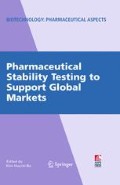Abstract
This article discusses the purpose of a drug substance specification and the variety of tests to be considered for inclusion. The relevance of these aspects to stability studies is examined and the differences between release testing and tests relevant to stability studies are explored. A scientific approach to setting drug substance specifications and to designing stability studies is encouraged and where necessary, the regulatory landscape is compared and contrasted to this approach.
Access this chapter
Tax calculation will be finalised at checkout
Purchases are for personal use only
Notes
- 1.
ICH Guideline Q1A(R2) Stability Testing of New Drug Substances and Products (Feb. 2003).
- 2.
ICH Guideline Q6A Specifications: Test Procedures and Acceptance Criteria for New Drug substances and New Drug Products (Oct. 1999).
- 3.
EMEA Requirements to the Chemical and Pharmaceutical Quality documentation concerning investigational medicinal products in clinical trials. CHMP/QWP/185401/2004final March 2006. http://www.emea.europa.eu/pdfs/human/qwp/18540104en.pdf
- 4.
FDA Guidance for Industry: INDs for Phase 2 and Phase 3 Studies Chemistry, Manufacturing, and Controls Information. http://www.fda.gov/cder/guidance/3619fnl.htm
- 5.
Technical Guide for the Elaboration of Monographs 4th Edition 2005 European Pharmacopoeia.
- 6.
Ref: Skrdla PJ et al. (2009) Use of a Quality-by-Design approach to justify removal of the HPLC weight % assay from routine API stability testing protocols, J. Pharm and Biomed Analysis, Available online 21 June 2009
- 7.
ICH Guideline Q3A(R2) Impurities in New Drug Substances (Oct. 2006).
- 8.
FDA Development of New Stereoisomeric Drugs. 5/1/92 Last update: July 6, 2005. http://www.fda.gov/cder/guidance/stereo.htm
- 9.
Guideline Q3C(R3). Impurities: Guideline for Residual Solvents (Nov. 2005).
- 10.
EMEA Guideline on the Specification Limit for Residues of Metal Catalysts or Metal Reagents. EMEA/CHMP/SWP/4446/2000 (Feb. 2008). http://www.emea.europa.eu/pdfs/human/swp/444600enfin.pdf
- 11.
Japanese Pharmacopoeia 15th Edition (Apr. 2006).
- 12.
FDA Drug Substance: Chemistry, Manufacturing, and Controls Information (2004 Draft.) Withdrawn as per FR notice June 1, 2006. http://www.fda.gov/cvm/Guidance/guide169.pdf
- 13.
EMEA CHMP Guideline on stability testing for applications for variations to a marketing authorisation CPMP/QWP/576/96 Rev.1 (2005) http://www.emea.europa.eu/pdfs/human/qwp/057696en.pdf
- 14.
Stability testing of active pharmaceutical ingredients and finished pharmaceutical products. In: WHO Expert Committee on Specifications for Pharmaceutical Preparations. Forty-third report. Geneva, World Health Organization, 2009, Annex 2 (WHO Technical Report Series, No. 953). <http://www.who.int/medicines/publications/pharmprep/pdf_trs953.pdf#page=101>
References
Carstensen T, Morris T (1993) Chemical stability of indomethacin in the solid amorphous and molten states. J Pharm Sci 82:657–659
Hancock BC, Zografi G (1997) Characteristics and significance of the amorphous state in pharmaceutical systems. J Pharm Sci 86(1):1–12
Humera A, Buckton G, Rawlins DA (1996) The use of isothermal microcalorimetry in the study of small degrees of amorphous content of a hydrophobic powder. Int J Pharm 130:195–201
Snorek SM, Bauer JF, Chidambaram N, Doub WH, Duffy EP, Etzler FM, Kelly RN, Lane JJ, Mueller RL, Prasanna HR, Pujara CP, Reif VD, Scarlett B, Stowell JG, Toma PH (2007) PQRI Recommendations on particle-size analysis of drug substances used in oral dosage forms. J Pharm Sci 96(6):1451–1467
Nichols G, Byard S, Bloxham MJ, Botterill J, Dawson NJ, Dennis A, Diart V, North NC, Sherwood JD (2002) A review of the terms agglomerate and aggregate with a recommendation for nomenclature used in powder and particle characterization. J Pharm Sci 91(10):2103–2109
Waterman KC, Carella AJ, Gumkowski MJ, Lukulay P, Macdonald BC, Roy MC, Shamblin SL (2007) Improved protocol and data analysis for accelerated shelf-life estimation of solid dosage forms. Pharm Res 24(4):780–790
Author information
Authors and Affiliations
Corresponding author
Editor information
Editors and Affiliations
Rights and permissions
Copyright information
© 2010 American Association of Pharmaceutical Scientists
About this chapter
Cite this chapter
Beaman, J.V. (2010). Setting Specifications for Drug Substances. In: Huynh-Ba, K. (eds) Pharmaceutical Stability Testing to Support Global Markets. Biotechnology: Pharmaceutical Aspects, vol XII. Springer, New York, NY. https://doi.org/10.1007/978-1-4419-0889-6_26
Download citation
DOI: https://doi.org/10.1007/978-1-4419-0889-6_26
Published:
Publisher Name: Springer, New York, NY
Print ISBN: 978-1-4419-0888-9
Online ISBN: 978-1-4419-0889-6
eBook Packages: Biomedical and Life SciencesBiomedical and Life Sciences (R0)


